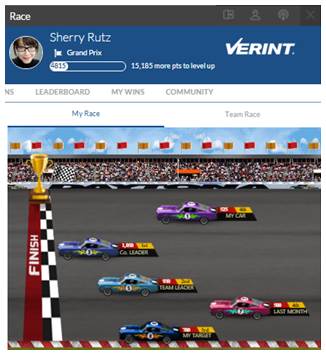Gamification Is the HOW of Performance Management
Performance management lets employees, managers and the organization know where they are achieving or falling short of their goals. But knowing where you need to improve—and how to improve—are two different things.
Gamification solutions such as Verint Gamification provide the how. It helps managers understand how to engage, influence and motivate employees—presenting employees with learning activities and next best actions they can take so they know how to improve their skills. 
Gamification works in tandem with performance management systems, limiting the KPIs to those that drive employee behavior and desired outcomes. Following are some of the key attributes of gamification that make it a compelling proposition for organizations wanting to improve performance.
Consumable. Gamification presents micro-learning that is easy to digest and can be taken at the employees’ convenience—between calls, tasks, on breaks, etc. Within the Verint solution you can build simulations, quizzes or link to videos or clips in your existing LMS system. Keeping these learning activities short but targeted helps make them more effective.
Progressive. It’s not so much about hitting KPIs but rather about modifying behaviors. Employees can see where they started and how far they’ve come—and are recognized for making progress on their goals. The tool has built-in levels to continually motivate employees to do better and grow their skills.
 Visual and Positive. Presented graphically in a game narrative, employees can easily see where they stand against goals, peers and their personal best, vs. a busy spreadsheet or monthly shared report summary. These often have too much data and graphs that focus on past performance and shortfalls vs. a positive focus on progress and future potential.
Visual and Positive. Presented graphically in a game narrative, employees can easily see where they stand against goals, peers and their personal best, vs. a busy spreadsheet or monthly shared report summary. These often have too much data and graphs that focus on past performance and shortfalls vs. a positive focus on progress and future potential.
Expansive. Shifts time and focus from 1-to-1 to 1-to-many. Instead of:
- Identifying skill deficiencies by employee and assigning 1-to-1 coaching or eLearning through targeted games or learning assignments, managers can now assign learning to multiple people, teams and/or business units with similar challenges to improve performance—saving manager time and extending the benefits beyond one employee to many.
- Recognizing goal achievements of a single employee in a 1 on 1 or a few in team meetings/calls, employees can be recognized by peers and other teams across the world for achievements.
- Relying on just their manager to answer questions, employees can build their own network of resources in the game community to ask questions.
Agile and Balanced. Gamification is not one and done. It’s a continual process to adapt the games to match the constantly changing priorities and needs of the organization. It also helps ensure checks and balance. Instead of pushing to improve one behavior, the games are designed to emphasize a desired behavior, perhaps through awarding higher points or a badge for taking related learning activities, but keep the other KPIs in focus as they are collectively needed to “win the game” and achieve performance goals.
Employees benefit from gamification because it makes it easy for them to understand how they can improve and rewards them for their efforts. The recognition and advancement in skills helps increase their job satisfaction and engagement. Organizations benefit by continually motivating employees to achieve their performance goals and, consequently, the company’s desired business outcomes.
Want to learn more about progressively improving employee performance? Read the Executive Perspectives: Moving the Middle.
The post Gamification Is the HOW of Performance Management appeared first on Customer Experience Management Blog.
Leave a Comment
You must be logged in to post a comment.







